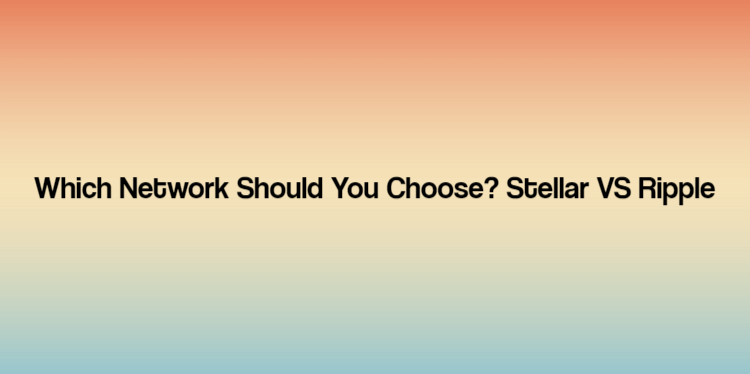Stellar and Ripple are two prominent blockchain-based payment platforms that have gained significant attention in the world of financial technology. Both platforms aim to revolutionize cross-border transactions by providing fast, secure, and cost-effective solutions. However, there are important distinctions between them that individuals and businesses should be aware of. In this article, we will explore the key differences between Stellar and Ripple, including their target audiences, consensus algorithms, native cryptocurrencies, and governance structures. By understanding these differences, you can make informed decisions about which platform aligns best with your specific needs and goals. Whether you are a financial institution looking to enhance your payment systems or an individual seeking financial inclusivity, this comparison will provide you with the essential information you need to know about Stellar and Ripple.

Page Contents
Which Network Should You Choose? Stellar VS Ripple
Cryptocurrencies are one of the most popular assets today. They’re important not only as an investment but also for the specific use cases they have. Bitcoin, the first crypto, is a great store of value and payment method. Ethereum, on the other hand, offers a range of use cases through its myriad of dApps.
You can convert your BTC to ETH to use your funds in DeFi protocols, where you can participate in lending, betting, or trading platforms. But there are also many other great cryptocurrencies, such as Stellar or Ripple, that focus on enabling cross-border payments in a secure, fast, and economical way.
Stellar Benefits
Stellar is a cutting-edge blockchain platform created in 2014 that focuses on providing a payment gateway for individuals and institutions alike. Built on a unique consensus algorithm, Stellar enables fast and secure transactions, making it an ideal platform for cross-border payments and remittances. Its cool feature is the ability to pay with fiat currencies in its blockchain. The platform can receive one fiat currency and pay in another, converting them through the XLM token within the protocol. This means that it can be used not only as a payment method but also as a decentralized exchange. These transactions, unlike centralized alternatives, are effective in 3 to 5 seconds, for a small fee of about 7 cents.
The Stellar Development Foundation has always focused on partnering with large corporations. In June 2022, they partnered with MoneyGram to allow their users to exchange crypto for cash using MoneyGram’s agents.
Ripple Benefits
The Ripple is a prominent blockchain-based payment protocol and digital currency platform that has made waves in the world of financial technology. With its focus on enabling fast and low-cost international money transfers, Ripple has garnered significant attention from financial institutions and businesses worldwide. It was launched in 2012. However, the original idea began in 2004 with a payment network called RipplePay. Similar to Stellar, Ripple is focused on providing a payment alternative for financial institutions and businesses. Its advantage over traditional methods of international payments, such as SWIFT, is its fast transaction speed and low fees. The network also allows users to convert the XRP token into fiat currencies.
Transactions, which are confirmed in about 4 seconds, are processed by a group of approved nodes, mostly corporations. In this way, they expect to be more compliant with financial regulations due to its higher degree of centralization than other cryptocurrencies. Ripple has had support from international banks like Santander and Royal Bank of Canada.
Stellar and Ripple: The Main Differences
Stellar and Ripple are two prominent blockchain-based payment platforms, each with its own unique features and goals. While both platforms aim to facilitate fast and low-cost cross-border transactions, there are several key differences between them.
One of them is the target audience, as Stellar also opens its platform to individual users. Another difference is that Ripple, in order to maintain its focus on corporate customers, sacrifices decentralization, one of the defining aspects of cryptocurrencies. Stellar loosens up on that front and is more decentralized.
You can get more information on their differences here: https://godex.io/blog/xlm-vs-xrp-stellar-vs-ripple-differences.
Conclusion
Although they may seem very similar, Stellar and Ripple also have important differences. They are both good alternatives for making international payments, and they both allow users to pay with fiat. They are also very similar in terms of speed and fees.
The most important thing to consider when choosing one or the other is your profile. Are you using it for personal use? Or are you looking for a more compliant alternative to crypto for your business? Make sure you do solid research before investing in any crypto project.